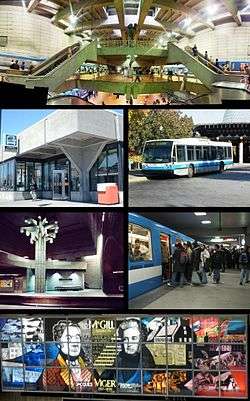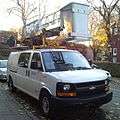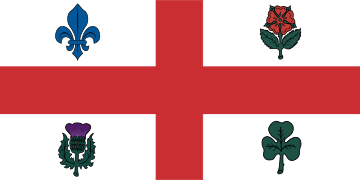Société de transport de Montréal
.svg.png) | |
|
Top: Lionel-Groulx Metro station and STM logo. Prior to 2002, it was referred to as STCUM.
Second row: Honoré-Beaugrand Metro station, a 1996 NovaBus LFS "167 Le Casino" leaving the Montreal Biosphère and heading to the Casino de Montréal. Third row: Georges-Vanier Metro station, Berri-UQAM Metro station. Bottom: Montreal's first two mayors, Jacques Viger and Peter McGill, in stained glass in the McGill Station of the Montreal Metro. | |
| Overview | |
|---|---|
| Locale | Agglomeration of Montreal |
| Transit type | Bus, Rapid Transit, Taxibus, Paratransit |
| Number of lines | 197 bus routes + 23 night routes, 4 subway lines [1] |
| Number of stations | 68[1] |
| Daily ridership | 2,099,800 (avg. weekday 2013) [2] |
| Chief executive | Philippe Schnobb |
| Headquarters | 800 rue de la Gauchetière Ouest, Montreal, Quebec, Canada |
| Website | English language website |
| Operation | |
| Began operation | 2002 |
| Operator(s) | Société de transport de Montréal |
The Société de transport de Montréal (STM) (English: Montreal Transit Corporation) is a public transport agency that operates transit bus, and rapid transit services in Montreal, Quebec, Canada. Established in 1861 as Montreal City Passenger Railway Company, it has grown to comprise four subway lines with a total of 68 stations, as well as over 186 bus routes and 23 night routes.
The STM operates the second most heavily used urban mass transit system in Canada after the Toronto Transit Commission, and the fourth most heavily used rapid transit system in North America, after the New York City Subway and the Mexico City Metro. As of 2011, the average daily ridership is 2,524,500 passengers: 1,403,700 by bus, 1,111,700 by rapid transit and 9,200 by paratransit service.[2]
The Société de transport de Montréal (STM) was created in 2002 to replace the Société de Transport de la Communauté Urbaine De Montréal (STCUM).
History
Several other public transport companies existed prior to the creation of the STM. From 1861 to 1886, the Montreal City Passenger Railway Company operated a small network of horse-drawn trams (also called streetcars in North America).
Then in 1886, the company changed its name to Montreal Street Railway Company. The first electric tram appeared in 1892 and was nicknamed the Rocket. The company underwent another name change in 1893: MSTR became the MTR for Montreal Island Beltline Railway. A year later, the network was fully electrified and in 1894, the last horse-drawn tram was taken out of service. From 1910 to 1911 the company was renamed Montreal Public Service Corporation before changing again to Montreal Tramways Company.
Although they were put into service in 1919, buses only began to be widely used starting in 1925, with the creation of several regular lines. Then in 1937, the first trolley buses were used. In 1939, the company had 929 trams, 224 buses and 7 trolley buses, serving about 200 million passengers per year. The replacement of tram lines by buses began in 1951, when a law was passed by the provincial government transferred the overall management of transport in Montreal to a public organization, the Commission de transport de Montréal (CTM). The last tram was withdrawn from service in 1959.
The Metro was inaugurated in 1966 and the same year saw the end of the trolley bus service.
The CTM became the Commission de transport de la communauté urbaine de Montréal (CTCUM) in January 1970, and in 1985, rebranded itself again by becoming the Société de Transport de la Communauté Urbaine De Montréal (STCUM). Commuter trains ceased to be the managed by the STCUM in 1996 and responsibility for this service was transferred to the newly created Agence métropolitaine de transport.
It was not until 2002, at the time of the time of the merger of Montreal with other municipalities on the Island of Montreal that the Société de transport de Montreal was created, taking the place of the STCUM.
| Name | Abbreviation | Start Year | Finish Year | Remarks |
|---|---|---|---|---|
| Société de transport de la communauté urbaine de Montréal | STCUM | 1985-06-20 | 2001-12-31 | Conversion to a crown corporation |
| Commission de transport de la communauté urbaine de Montréal | CTCUM | 1970-01-01 | 1985-06-19 | Creation of the Montreal Urban Community |
| Commission de transport de Montréal | CTM | 1951-06-16 | 1969-12-31 | Municipal corporation formed to take over assets of MTC |
| Montreal Tramways Company | MTC | 1911-03-24 | 1951-06-15 | New company from merger from MSRC, Montreal Park & Island Railway Company, and Montreal Terminal Railway Company |
| Montreal Street Railway Company | MSRC | 1886-06-21 | 1911-03-23 | New name |
| Montreal Park and Island Railway[5] | ? | 1893-12-27 | 1911 | Transferred to Montreal Tramways |
| Montreal City Passenger Railway Company | MSR | 1861-05-18 | 1886-06-20 | Street railway service began 1861-11-27 |
Streetcars

From 1861 to 1959, Montreal had an extensive streetcar system. The streetcar network had its beginnings with the horsecar era of the Montreal City Passenger Railway in 1861. That private company would become the Montreal Street Railway in 1886 and the Montreal Tramways Company in 1911. The assets of the company were taken over by the city-owned Montreal Transportation Commission in 1951.
Regional transit service
The STM was formerly involved in the operation of regional transit services. The first such service was a set of bus routes inherited from the October 1980 expropriation of a private bus company called Metropolitan Provincial (1967) Inc. These regional bus routes operated from downtown Montreal to the western part of the Island of Montreal, as well as to off-island points located west, south-west, and north east of the Island of Montreal. By the end of 1985, the STM (then known by the initials CTCUM) had exited the regional bus business to focus on its core territory (the Island of Montreal). Most of the regional bus routes were passed to private operators who provided services under contract to newly formed intermunicipal transit councils.
The second regional service involved the management of two commuter train lines. On July 1, 1982, the CTCUM and the Canadian National Railway (CN) entered into an agreement to integrate the Montreal-Deux Montagnes commuter train line into the regular CTCUM bus and Metro network. The CTCUM paid CN to staff, run, and maintain the trains, while it set the fares and schedules. Passengers travelling within the CTCUM operating territory were able to transfer between the trains and the bus or Metro, no fare supplement was required to make a bus/Metro to train transfer . On October 1, 1982, a similar agreement with the Canadian Pacific Railway (CP) went into effect and CP's Montreal-Rigaud commuter train line was integrated into the CTCUM network.
On January 1, 1996, responsibility for the commuter trains was transferred to the AMT, a Quebec provincial government agency formed to coordinate all public transportation in the metropolitan Montreal region.
Services
Fares
Fares for the Metro and buses are fully integrated, a ticket entitling the passenger to a complete trip, regardless of the mode of transportation used or the number of transfers required (within a time frame of 120 minutes). The tickets come in various forms: magnetized tickets, weekly and monthly magnetized cards and magnetized cards for bus transfers are inserted in the appropriate card readers at turnstiles in the Metro, and in the terminals present when boarding the bus. Tickets for reduced fares are non-magnetized and must be presented upon entry.
The entire STM network can be accessed with the same fares, with the exception of the Metro stations located in Laval (Cartier, De La Concorde and Montmorency) and Longueuil (Longueuil–Université-de-Sherbrooke).
Rates are also partially integrated with those of Agence métropolitaine de transport. There are five intermodal stations that provide correspondence between the Metro and commuter trains. Four of these stations are on the Orange line (Vendôme Lucien-L'Allier Bonaventure, De la Concorde and one is on the Blue line (Parc).
The STM accepts cash, tickets (for Students and Seniors), as well as daily, weekly, and monthly passes. When a ticket or cash fare is used, a free transfer can be used for trips in one direction that are completed within two hours. As of January 1, 2013[6] basic fares are shown below.
| Fare | Full | Reduced (Students 6-17, Seniors 65+) |
|---|---|---|
| Single trip, cash | $3.25 | $2.25 |
| Weekly Pass | $25.75 | $15.75 |
| Monthly Pass | $83.00 | $49.75 (Students 6-25) |
| 4 month Pass | N/A | $197.00 |
| Three-Day Pass | $18 | |
| One-Day Pass | $10 |
Except for cash, these and other fares are stored on an OPUS card. Children 5 years of age and younger, accompanied by an adult, travel for free. Children under 5 cannot travel unaccompanied.
OPUS
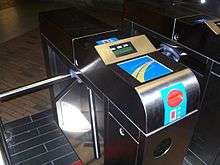
On April 21, 2008, the STM unveiled the contactless smart card called OPUS (a word that phonetically includes the French word puce, which is the generic French word for the chip used in any type smart card [7]) as a means of fare payment. In preparation for this new step in Montreal's public transportation network, turnstiles which incorporate the reader and automated vending machines had already been installed in Metro stations; buses had previously been fitted with new fare boxes that incorporate the card reader, in order to ensure the uniformity of methods of payment across Montreal's transit network and that of its suburbs.
Costs to the STM related to the project were approximately $138 million, compared to the original estimated cost of some $100 million. The project was originally supposed to be implemented in 2006.
Schedules and route information
Route information can be accessed through a variety of methods:
- By telephone at 514-288-6287 (which spells "AUTOBUS" on many telephone keypads);
- Online in several formats at STM.info;
- Via systems capable of making use of the General Transit Feed Specification such as Google Maps;
- Via SMS.[8]
Each stop on each route is assigned a number and some of these systems require a user to know the number.
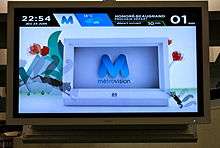
In 2014 the STM will introduce iBus, a real-time GPS tracking system. It will include electronic signs inside buses showing the estimated time of arrival at upcoming stops and the busiest bus stops will have electronic signs showing the estimated time of arrival of the next bus.[9]
A handful of Metro stations are equipped with the MétroVision information screens which displays advertising, news headlines and weather information from RDI and MétéoMédia, as well as STM-specific information regarding service changes, service delays and information pertaining to using the system. Over time, the STM plans to have the screens in all 68 Metro stations.[10]
As of March 2014, 62 of the 68 stations are now equipped with the Metrovision screens.[11]
Accessibility
All 197 daytime bus routes and 23 night routes are wheelchair accessible. However, only one out of the four Metro lines is accessible to wheelchairs. The Orange line has 8 stations with elevators installed : Côte-Vertu, Lionel-Groulx, Bonaventure, Champ-de-Mars, Berri-UQAM, Henri-Bourassa, Cartier, De La Concorde, and Montmorency.
Jean-Talon and Snowdon stations are to have elevators installed beginning in 2013, and Vendôme, Mont-Royal beginning in 2014, and Rosemont beginning in 2015.[12]
Connections to other transit services
STM is connected to surrounding transit agencies such as:
- Société de transport de Laval (STL) — City of Laval
- Réseau de transport de Longueuil (RTL) — City of Longueuil
- Agence métropolitaine de transport (AMT) — provides commuter rail service to Vaudreuil-Hudson, Deux-Montagnes, Saint-Jérôme, Mont Saint Hilaire, Candiac and Mascouche lines (AMT).
- A number of intermunicipal transit organizations known as Conseil Intermunicipale de Transport (CITs) which provide service to suburban and rural areas such as Châteauguay, Salaberry-de-Valleyfield, Saint-Jean-sur-Richelieu, Saint-Hyacinthe, Sorel-Tracy, Repentigny, Terrebonne, and Saint-Jérôme.[13]
Budget
The STM's budget comes from ticket fares and government funding. The STM's 2000 budget was 620 million dollars. The 2012 budget was 1.2 billion dollars of witch 0.9% was dedicated to fixing old infrastructure.The 2016 budjet include a 175 million in Réno-Infrastructures and Réno-Systèmes to improve the metro system.
In 1985, the fare cost 85 cents. Ticket fares have been increasing slightly every year. Last increase was from $3.00 to the current $3,25
Security
The Service de police de la Ville de Montréal has a Unité métro (Metro Unit) that patrols Metro trains and stations. This unit has been in service since 2007.[14]
Since the start of Metro service in 1966, the STM (and predecessors) has had its own transit safety force. STM Transit Safety Agents are not armed with a firearm but are provided with a baton and handcuffs.
Incidents
On May 10, 2012, smoke bombs were set off at Lionel-Groulx, Jean-Talon, Préfontaine, Fabre and Pie-IX stations, resulting in evacuations of the affected stations and a complete shutdown of the Metro for over two hours. The incident was not officially linked to the 2012 Quebec student strike.[15]
Transit modes
Metro
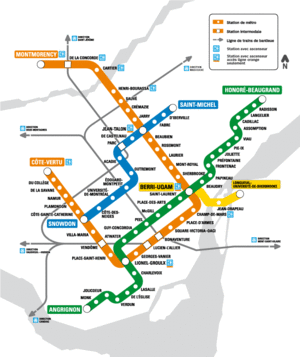
The Montreal Metro rapid transit system was introduced in 1966 in preparation for the Canadian Centennial and Expo 67 World Fair in Montreal. Instead of traditional steel-wheeled trains, it is a rubber-tired metro, based on technology developed for the Paris Métro; Montreal's system was the first in the world to be entirely rubber-tired (as not all of Paris's lines use tires). The Metro system is Canada's busiest subway system in total daily passenger usage; in 2010, serving an average of 1,111,700 daily passengers on an average weekday; a figure which surpassed that of the Toronto subway and Vancouver SkyTrain.[2] That year, 296.3 million riders (transfers not included) used the Metro,[16] which since its opening had transported over 7 billion passengers as of 2010, roughly equivalent to the world's population.
| Line Number | Colour | Termini |
|---|---|---|
| 1 | Green | Honoré-Beaugrand - Angrignon |
| 2 | Orange | Montmorency - Côte-Vertu |
| 4 | Yellow | Berri-UQAM - Longueuil–Université-de-Sherbrooke |
| 5 | Blue | Saint-Michel - Snowdon |
Bus services

The STM bus service operates well over 200 bus routes serving a number of different markets. These routes serve an average of 1,403,700 daily passengers each weekday.[2]
- Local network routes, numbered 10-299, generally operate seven days per week, from 5:00 am to 1:00 am. Some routes offer decreased services on weekends and holidays. Within this classification, some routes operate only at peak hours Monday through Friday, and sometimes only in peak directions. The Navettes Or, numbered above 250, are specifically designed to serve the needs of senior citizens.
- All-night network routes, with route numbers from 300-399, generally operate from 1:00 am to 5:00 am, seven days per week, at a maximum headway of 45 minutes. Some routes offer increased service early on Saturday and Sunday ("late" on Friday and Saturday).
- Express Network routes, numbered 400-499, are limited-stop routes. Some routes are classified as Metrobus, and Trainbus and are geared to deliver commuters to specific Metro and commuter train stations, although these designations are no longer in use. Most Express routes operate only at peak hours Monday through Friday, and sometimes only in peak directions.
- Shuttle Network routes, numbered 700-799, are special-purpose routes serving Canadiens hockey games, tourist areas like Old Montreal and La Ronde, as well as an express route running 24/7 between downtown and Montréal–Pierre Elliott Trudeau International Airport.
On August 30, 2010, the STM introduced the 10 Minutes Max network. This "network", overlaid on both the local and express networks described above, schedules buses at a maximum headway of 10 minutes, between 6 a.m. and 9 p.m., Monday to Friday, on 31 of the STM's busiest bus routes.[17] A few routes support that maximum headway only in the customary peak direction mornings and afternoons, while some routes outside of the advertised network attain similarly short headways but within shorter periods.
In early 2012, the STM announced a plan to convert its entire fleet of buses over to electric power by 2020. Beginning in 2012, all STM bus purchases will be either hybrids or electrics and, starting in 2011, Montreal will begin testing trolley buses (electric buses powered by overhead wires) on some of the city's busiest routes.[18]
Taxibus
The STM also operates ten taxibus lines where the creation of regular bus service is not feasible. Regular STM fares apply, except that no cash is accepted.[19]
- Baie-d'Urfé, connecting to Baie-d'Urfé commuter railway station
- Stewart Hall, connecting to various locations in Pointe-Claire
- Île-des-Soeurs, connecting to Place du Commerce
- Lachine, connecting to Lachine commuter railway station
- L'Île-Bizard, connecting to bus route 407 Express Île-Bizard
- Norman, connecting Lachine's residential neighborhoods to the industrial area north of Highway 20
- Lachine Industrial Park, connecting to Dorval commuter railway station
- Phillips Avenue (Senneville), connecting to bus route 419 Express John Abbott
- Sainte-Anne-de-Bellevue, Sainte-Marie district, connecting to Sainte-Anne-de-Bellevue commuter railway station
- Senneville, connecting to Sainte-Anne-de-Bellevue commuter railway station
- Montreal Technoparc, connecting to Sunnybrooke commuter railway station
Paratransit Service
The Société de Transport de Montréal operates a paratransit service for people with mobility problems. The lack of subway accessibility is critical for people whose mobility needs cannot be accommodated by stairs. STM's adapted transit is a system based on reservation, meaning that there is no room for flexibility. All trips must be booked at least one day in advance. Service began in April 1980. In first quarter, 2011, 9,200 trips were made through this service daily.[2]
Current Vehicles
The STM operates over 1,800 buses in its fleet. Since 2012 the active fleet is composed exclusively of buses from the Nova Bus LF Series.
| Current Société de transport de Montréal Vehicles | |||||
|---|---|---|---|---|---|
| Photo | Manufacturer | Years | Model | Remarks | Fleet numbers |
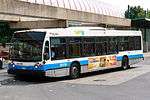 |
Nova Bus | 2001–2004 | LFS Second Generation |
|
21-202 to 24-307 |
 |
Nova Bus | 2005–2009 | LFS Second Generation |
|
25-201 to 29-071 |
 |
Nova Bus | 2008, 2016 | LFS HEV |
|
28-701 to 28-708, 36-001 to 36-027 |
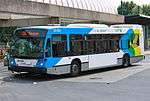 |
Nova Bus | 2009–2012 | LFS Third Generation |
|
29-072 to 32-032 |
| Nova Bus | 2009–2013 | LFS Artic |
|
29-801 to 33-845 | |
| |||||
Infrastructure
Termini
Most STM bus routes terminate at loops, side streets or Metro stations.
Regional Termini
- Terminus Angrignon
- Terminus Côte-Vertu
- Terminus Dorval
- Terminus Fairview
- Terminus Henri-Bourassa Nord
- Terminus Henri-Bourassa Sud
- Terminus Honoré-Beaugrand
- Terminus Radisson
Other smaller STM loops/termini include
- Terminus Anjou
- Terminus Atwater
- Terminus Jolicoeur
- Terminus Lafleur-Newman
- Terminus MacDonald
- Terminus Sherbrooke/Gouin
- Terminus Vendôme
- Terminus 100th Avenue
- Beaubien Loop
- Crémazie Loop
- Laurier Loop
- Rosemont Loop
- Villa Maria Loop
- Du College Loop
Facilities
STM buses are operated out of a number of garages located around the city. They are Anjou, Crémazie, Frontenac, LaSalle, Legendre, Mont-Royal, Stinson, St-Denis, St-Laurent and St-Michel for Paratransit. The surface routes are divided into several divisions. Individual divisions have a superintendent, an on-duty mobile supervisor, a communications centre, and a garage facility tasked with managing the division's vehicle fleet and routes.
Metro trains are stored in the four garages at Angrignon, Beaugrand, Montmorency and Saint-Charles and there are three maintenance facilities at Duvernay, Plateau d'Youville and Viau.
Stops and shelters
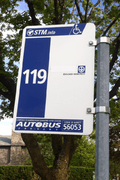
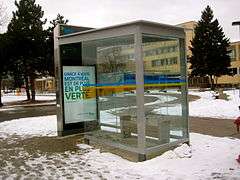
There are 8,500 bus stops in the STM network. Each stop has a panel that indicates the number of routes that stops there, the type of service, if the bus goes to a Metro or train station and the bus stop code enabling one to obtain the schedule by telephone at 514-AUTO-BUS. The STM is in the process of changing all its bus stop panels to a new modern pole that displays the route numbers. The route number is color-coded for the type of service it offers, dark blue is for regular routes, green is for express, metrobus and R-bus routes, black for night routes and gold for senior shuttles. Advertising is provided by CBS. On November 8, 2010 the STM launched 3 prototypes of modern bus shelters to replace the old ones. They will run on a solar power system and lights in the shelter are to be controlled by motion sensor. Bus shelters at high-traffic intersections feature an interactive screen where people can use hand gestures to access weather, news and bus route information. Since the introduction of GPS in the fleet, the screen can also be used to track busses on the route.[21]
See also
References
- 1 2 Everything about the STM
- 1 2 3 4 5 http://www.apta.com/resources/statistics/Documents/Ridership/2013_q2_ridership_APTA.pdf
- ↑ "Company Timeline". Stm.info. Retrieved 2013-04-11.
- ↑ Binns, Richard. Montreal's Electric Streetcars. Railfare.
- ↑ Montreal Park and Island Railway
- ↑ "STM Fare Information". STM. Retrieved 25 March 2013.
- ↑ http://www.stm.info/t-adapte/faq.htm
- ↑ "Press releases". Stm.info. 2009-07-14. Retrieved 2012-01-02.
- ↑
- ↑ http://www.stm.info/english/info/a-travaux_ecrans.htm
- ↑ http://www.metrovision.ca/exclusif#exclusivite-201
- ↑ http://www.stm.info/english/info/a-travaux.htm
- ↑ AMT bus connections
- ↑ "Montréal metro". Service de police de la Ville de Montréal. Retrieved 1 April 2013.
- ↑ Montreal Metro Shutdown
- ↑ http://www.apta.com/resources/statistics/Documents/Ridership/2010_q4_ridership_APTA.pdf
- ↑ "Un bus toutes les 10 minutes, au maximum". Radio-canada.ca.
- ↑ Eric Loveday RSS feed. "Montreal's 1,300-plus bus fleet going all electric by 2025". Green.autoblog.com. Retrieved 2012-01-02.
- ↑ STM, Taxibus service
- ↑ Bike + Bus = Partners in Road Safety
- ↑ http://www.stm.info/en/info/advice/transit-shelters
